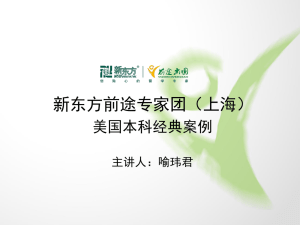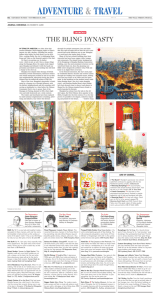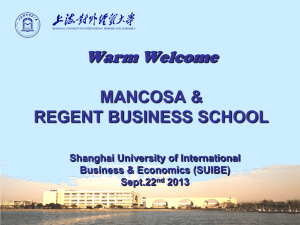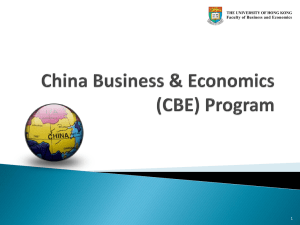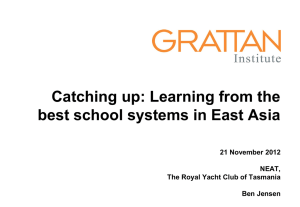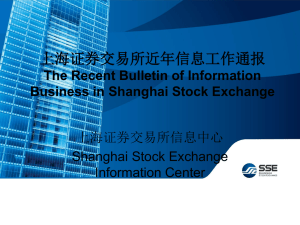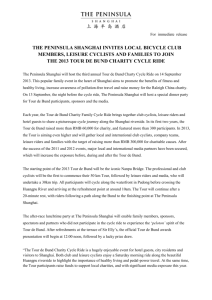PowerPoint 演示文稿
advertisement
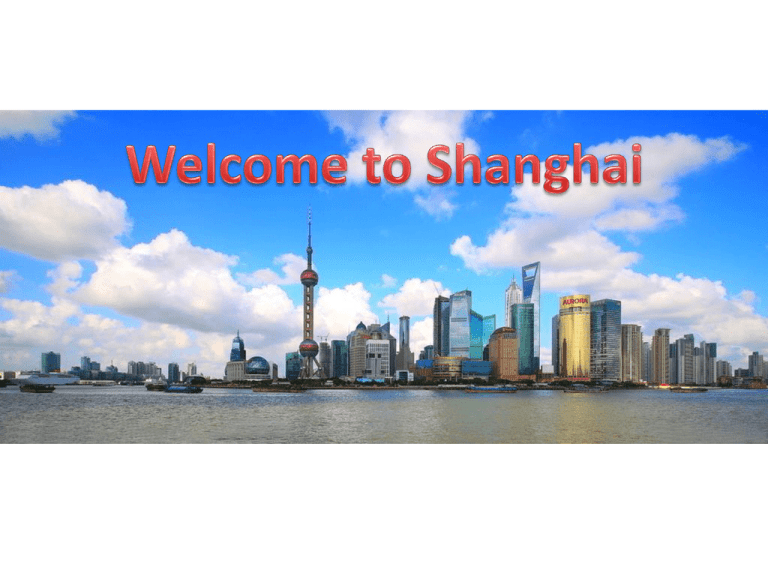
World Architecture at the Bund The Bund is a symbol of Shanghai. The Bund has dozens of historical buildings, lining the Huangpu River, that once housed numerous banks and trading houses from the United Kingdom, France, the United States, Italy, Russia, etc. The Bund houses 52 buildings of various architectural styles such as Romanesque, Gothic,Renaissance, Baroque, Neo-Classical,Beaux-Arts, and Art Deco. The buildings are harmonious in color and style, thus gaining the name of "Gallery of World Architecture". When night falls and the lights are on, all the buildings are lit with colorful lights, glistening and dazzling to the eye. Waibaidu Bridge Spanning over Suzhou Creek, Waibaidu Bridge is a wellknown bridge. It was first built in I 855 of wood and rebuilt in I 907 in iron and steel The bridge is 1 06.7-m long, with a load of 20 tons, a traffic lane of 11.2 m and 3.6-m wide sidewalks on both sides. It was once the most elegant and magnificent bridge in the city and, up to now, it is still considered one of the symbols of Shanghai. Shanghai Museum Construction of the current building started in August 1993. It was inaugurated in October 12, 1996. It is 29.5 meters high with five floors, covering a total area of 39,200 m². Designed by a local architect, the new museum building is designed in the shape of an ancient, bronze, tripod cooking vessel called a ding. It is said that the inspiration for the design was specifically provided by the Da Ke Ding, now on exhibit in the museum. The building has round top and a square base, symbolising the ancient Chinese perception of the world as "round sky, square earth". The museum has a collection of over 120,000 pieces, including bronze, ceramics, calligraphy, furniture, jades, ancient coins, paintings, seals, sculptures, minority art and foreign art. It has eleven galleries and three special temporary exhibition halls. Yuyuan Garden A famous classical garden in south China , it was once famed as the “top beauty in southeast China”. First built during the Ming Dynasty, 400 years ago, by a Sichuan minister of finance named Pan Yunduan, it has been several times renovated by the government since the Liberation and is now one of the key relic sites in the country under state protection. The garden is divided into the scenic sections of “Mountains and Forests in the City”, "Magnificent Woods and Beautiful Valleys”, "Historical Relics of Heralding Spring”, "Water and Rockery Scenery”, "Tops in the World” and the Inner Garden. Shanghai Old Street The 825-m long Old Street runs from Renmin Rd. to Henan Rd. . It is an important thoroughfare for visiting the Yuyuan commercial area. In old Shanghai here were found the private banks, gold shops, jewelry stores, wine shops, tea houses, theatres, and other firms, usually called the center of all trades in Shanghai. Here, now, we can find some of the traditional trades like a coin store, old-fashioned tea houses, a shop selling mahogany decorative articles, a pawn shop, a wine shop and a private bank. Nanjing Road Pedestrian Walkway Nanjing Rd., famed as “No. 1 Street in China”, is an epitome of Shanghai 's history and culture. The 1,033-m long Pedestrian Walkway lies between the Bund and the People's Square. There are more than 600 shops on both sides of the walkway. There are not only 100-year old ones, famous brand ones but also specialty shops of different trades. At night, the whole walkway is lit up. Xintiandi Xintiandi is a car-free shopping, eating and entertainment area of Shanghai. It is composed of an area of restored traditional shikumen ("stone gate") houses on narrow alleys, a modern shopping mall with a cinema complex, and some adjoining houses which now serve as book stores, cafes and restaurants. Most of the cafes and restaurants feature both indoor and outdoor seatings. Xintiandi has an active nightlife on weekdays as well as weekends, though romantic settings are more common than loud music and dance places. Xintiandi means "New Heaven and Earth", and is considered one of the first lifestyle centers in China. Xintiandi is near the site of the First Congress of the Communist Party of China. The Oriental Pearl TV Tower The Oriental Pearl TV Tower is located at the tip of Lujiazui in the Pudong district, by the side of Huangpu River, opposite The Bund of Shanghai. It was designed by Jia Huan Cheng of the Shanghai Modern Architectural Design Co. Ltd. Construction began in 1991 and the tower was completed in 1995. At 468 m (1,535 feet) high, it was the tallest structure in mainland China from 1994–2007, when it was surpassed by the Shanghai World Financial Center. The Oriental Pearl TV Tower belongs to the World Federation of Great Towers. Century Park Century Park is the largest park of the city of Shanghai. It is situated in Pudong New Area. The Shanghai Science and Technology Museum is located nearby. The park includes a concert stage, and visitors can hire tandem bicycles or cycling-cars to travel through it. The park's landscaping combines British, Japanese, and Chinese gardening styles.

